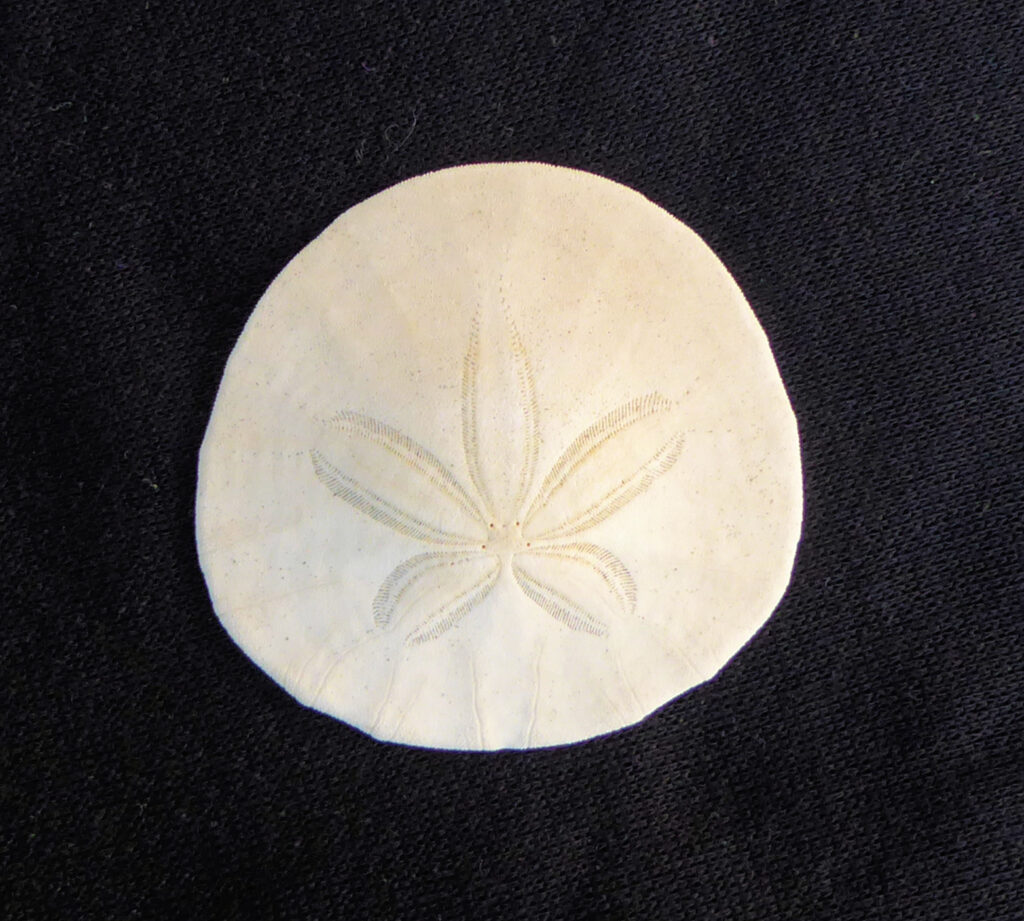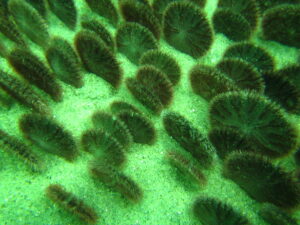Eccentric Sand Dollar, Dendraster excentricus

 Eccentric Sand Dollar, Dendraster excentricus. Sand Dollar collected in shallow water off San Quintin, Baja California, July 1998. Diameter: 6.5 cm (2.6 inches); depth: 0.9 cm (0.4 inches).
Eccentric Sand Dollar, Dendraster excentricus. Sand Dollar collected in shallow water off San Quintin, Baja California, July 1998. Diameter: 6.5 cm (2.6 inches); depth: 0.9 cm (0.4 inches).
 Eccentric Sand Dollar, Dendraster excentricus. Underwater photograph taken in Mission Bay, San Diego, California. July, 2019. Photograph courtesy of Bob Hillis, Ivins, Utah.
Eccentric Sand Dollar, Dendraster excentricus. Underwater photograph taken in Mission Bay, San Diego, California. July, 2019. Photograph courtesy of Bob Hillis, Ivins, Utah.
Phylogeny: The Eccentric Sand Dollar, Dendraster excentricus (Eschscholtz, 1831), is a member of the Dendrasteridae Family of Sand Dollars. The genus Dendraster is the only genus in this family and there are three species in this genus. This species is also known as the Common Sand Dollar, the Pacific Sand Dollar and the Western Sand Dollar and in Mexico as galleta de mar excentrica. They are named for the location of their flower pattern on the dorsal (arboral) side, which is off-center.
Morphology: Eccentric Sand Dollars have a circular outline. They have an extremely flattened rigid test (skeleton). The test consists of plates arranged in a five-fold radial symmetrical pattern. The dorsal side of the test is slightly humped and the oral surface (underside) is flat. The test is covered by a skin with short spines. They use the spines on their underside to move across the seabed. On their dorsal surface they have a petal-like pattern that consists of five paired rows of pores. The mouth of the sand dollar is located at the center of the underside. Living animals may be brown, gray or purple in color which quickly fades to a bleached white upon death. Eccentric Sand Dollars reach a maximum of 10.0 cm (3.9 inches) in diameter.
Habitat and Distribution: Eccentric Sand Dollars reside in sand substrate in bays, channels, and along exposed coastlines from the intertidal zone to depths up to 40 m (131 feet). In areas of strong current, they bury their anterior in the sand, with their posterior end sticking up. They are usually found in dense colonies (sometimes more than 600 per square meter) with densities increasing in areas with enhanced current flow. In areas with wave activity, they align themselves to face at a 90 degree angle to the wave direction. Astute divers can navigate by the position of these animals. In Mexican waters the Eccentric Sand Dollar is a resident of the Pacific but has a limited range being found only from Magdalena Bay, Baja California Sur northward along the central and northwest coasts of Baja California. They are absent from the Gulf of California.
Diet: The Eccentric Sand Dollar positionsthemselves with their mouth facing into the current, and capture and consume copepods, larval crabs, and other prey that are being carried in the current. In areas without current, they feed on detritus deposited on, or between, grains of sand. They consume algae, copepods, crustacean larvae, and detritus.
Predators: Eccentric Sand Dollars are preyed upon by shore birds, crabs, and fish, including the California Sheephead, Semicossyphus pulcher, and the Starry Flounder, Platichthys stellatus. They are also eaten by starfish including the Giant Pink Star, Pisaster brevispinus.
Reproduction: Eccentric Sand Dollars are gonochoric (male or female for life). Reproduction is sexual, with external fertilization. Eggs are brooded by the parents and the planktonic larvae metamorphose through several stages over a long period of time before the test forms, at which point they become benthic. Small Sand Dollars ingest large sand grains to add weight in order to better anchor themselves to the bottom. Sand dollars also have the capability of asexual reproduction, through larval cloning. They have life spans of up to fifteen years.
Ecosystem Interactions: Eccentric Sand Dollars sometimes host the Red-striped Acorn Barnacle, Paraconcavus pacificus. This relationship appears not to hurt the Sand Dollar, while giving the barnacle structure to attach to. Eccentric Sand Dollars are parasitized by the intestinal flatworm Syndesmis dendrastorum.
Human Interactions: Dredging and bottom trawling can destroy local colonies of Eccentric Sand Dollars. From a conservation perspective they have not been formally evaluated however they are fairly common with a relatively wide distribution and should be consider to be of Least Concern.
Synonyms: Echinarachinus excentricus and Scutella excentrica.